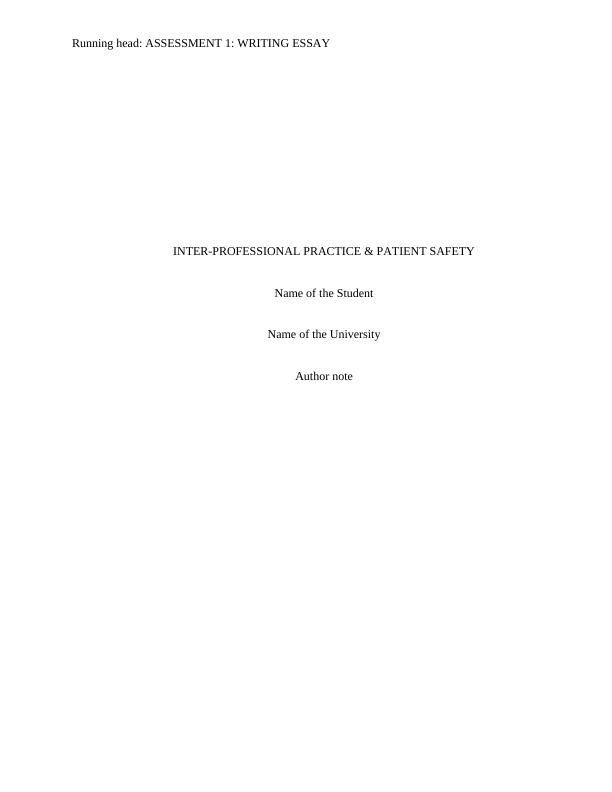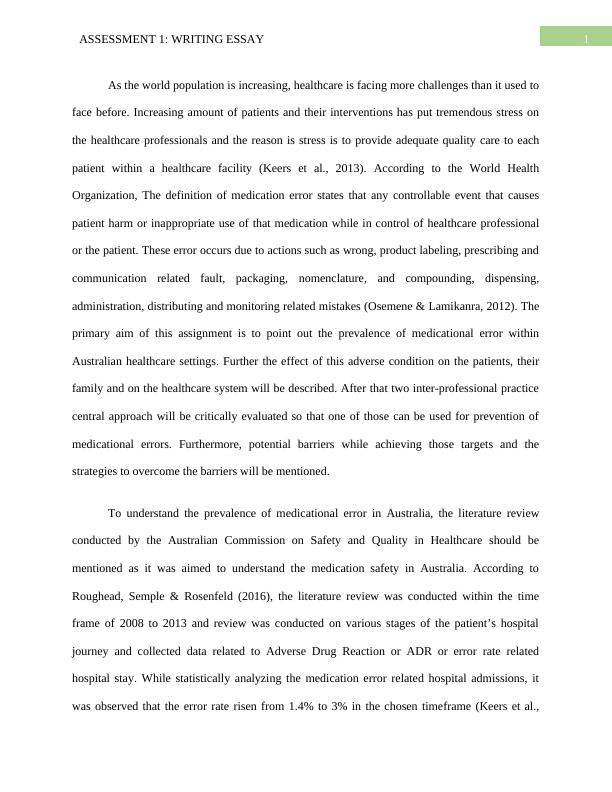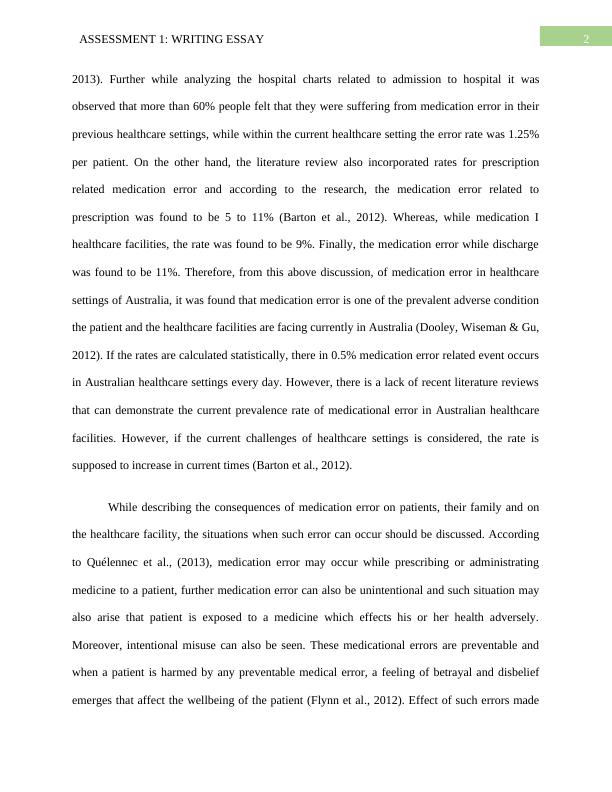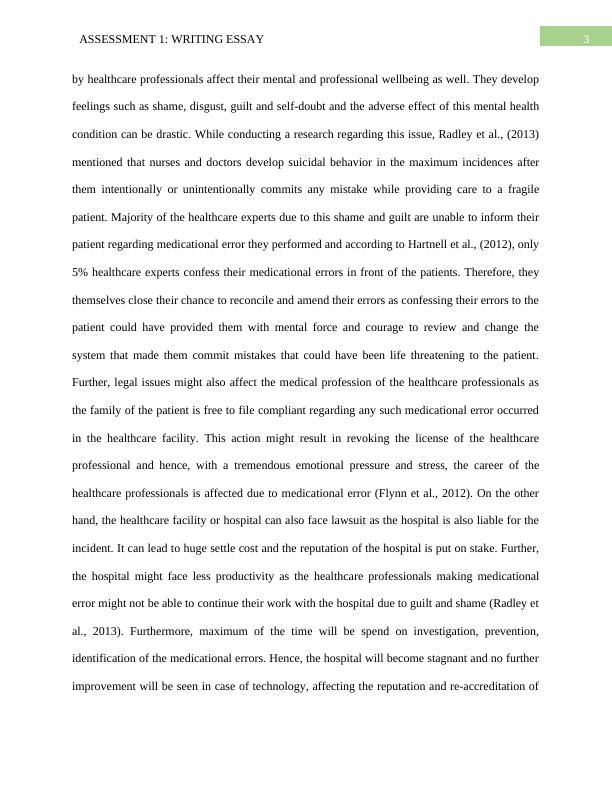Prevalence and Prevention of Medication Errors in Australian Healthcare Settings
Added on 2023-06-13
13 Pages3637 Words303 Views
Running head: ASSESSMENT 1: WRITING ESSAY
INTER-PROFESSIONAL PRACTICE & PATIENT SAFETY
Name of the Student
Name of the University
Author note
INTER-PROFESSIONAL PRACTICE & PATIENT SAFETY
Name of the Student
Name of the University
Author note

1ASSESSMENT 1: WRITING ESSAY
As the world population is increasing, healthcare is facing more challenges than it used to
face before. Increasing amount of patients and their interventions has put tremendous stress on
the healthcare professionals and the reason is stress is to provide adequate quality care to each
patient within a healthcare facility (Keers et al., 2013). According to the World Health
Organization, The definition of medication error states that any controllable event that causes
patient harm or inappropriate use of that medication while in control of healthcare professional
or the patient. These error occurs due to actions such as wrong, product labeling, prescribing and
communication related fault, packaging, nomenclature, and compounding, dispensing,
administration, distributing and monitoring related mistakes (Osemene & Lamikanra, 2012). The
primary aim of this assignment is to point out the prevalence of medicational error within
Australian healthcare settings. Further the effect of this adverse condition on the patients, their
family and on the healthcare system will be described. After that two inter-professional practice
central approach will be critically evaluated so that one of those can be used for prevention of
medicational errors. Furthermore, potential barriers while achieving those targets and the
strategies to overcome the barriers will be mentioned.
To understand the prevalence of medicational error in Australia, the literature review
conducted by the Australian Commission on Safety and Quality in Healthcare should be
mentioned as it was aimed to understand the medication safety in Australia. According to
Roughead, Semple & Rosenfeld (2016), the literature review was conducted within the time
frame of 2008 to 2013 and review was conducted on various stages of the patient’s hospital
journey and collected data related to Adverse Drug Reaction or ADR or error rate related
hospital stay. While statistically analyzing the medication error related hospital admissions, it
was observed that the error rate risen from 1.4% to 3% in the chosen timeframe (Keers et al.,
As the world population is increasing, healthcare is facing more challenges than it used to
face before. Increasing amount of patients and their interventions has put tremendous stress on
the healthcare professionals and the reason is stress is to provide adequate quality care to each
patient within a healthcare facility (Keers et al., 2013). According to the World Health
Organization, The definition of medication error states that any controllable event that causes
patient harm or inappropriate use of that medication while in control of healthcare professional
or the patient. These error occurs due to actions such as wrong, product labeling, prescribing and
communication related fault, packaging, nomenclature, and compounding, dispensing,
administration, distributing and monitoring related mistakes (Osemene & Lamikanra, 2012). The
primary aim of this assignment is to point out the prevalence of medicational error within
Australian healthcare settings. Further the effect of this adverse condition on the patients, their
family and on the healthcare system will be described. After that two inter-professional practice
central approach will be critically evaluated so that one of those can be used for prevention of
medicational errors. Furthermore, potential barriers while achieving those targets and the
strategies to overcome the barriers will be mentioned.
To understand the prevalence of medicational error in Australia, the literature review
conducted by the Australian Commission on Safety and Quality in Healthcare should be
mentioned as it was aimed to understand the medication safety in Australia. According to
Roughead, Semple & Rosenfeld (2016), the literature review was conducted within the time
frame of 2008 to 2013 and review was conducted on various stages of the patient’s hospital
journey and collected data related to Adverse Drug Reaction or ADR or error rate related
hospital stay. While statistically analyzing the medication error related hospital admissions, it
was observed that the error rate risen from 1.4% to 3% in the chosen timeframe (Keers et al.,

2ASSESSMENT 1: WRITING ESSAY
2013). Further while analyzing the hospital charts related to admission to hospital it was
observed that more than 60% people felt that they were suffering from medication error in their
previous healthcare settings, while within the current healthcare setting the error rate was 1.25%
per patient. On the other hand, the literature review also incorporated rates for prescription
related medication error and according to the research, the medication error related to
prescription was found to be 5 to 11% (Barton et al., 2012). Whereas, while medication I
healthcare facilities, the rate was found to be 9%. Finally, the medication error while discharge
was found to be 11%. Therefore, from this above discussion, of medication error in healthcare
settings of Australia, it was found that medication error is one of the prevalent adverse condition
the patient and the healthcare facilities are facing currently in Australia (Dooley, Wiseman & Gu,
2012). If the rates are calculated statistically, there in 0.5% medication error related event occurs
in Australian healthcare settings every day. However, there is a lack of recent literature reviews
that can demonstrate the current prevalence rate of medicational error in Australian healthcare
facilities. However, if the current challenges of healthcare settings is considered, the rate is
supposed to increase in current times (Barton et al., 2012).
While describing the consequences of medication error on patients, their family and on
the healthcare facility, the situations when such error can occur should be discussed. According
to Quélennec et al., (2013), medication error may occur while prescribing or administrating
medicine to a patient, further medication error can also be unintentional and such situation may
also arise that patient is exposed to a medicine which effects his or her health adversely.
Moreover, intentional misuse can also be seen. These medicational errors are preventable and
when a patient is harmed by any preventable medical error, a feeling of betrayal and disbelief
emerges that affect the wellbeing of the patient (Flynn et al., 2012). Effect of such errors made
2013). Further while analyzing the hospital charts related to admission to hospital it was
observed that more than 60% people felt that they were suffering from medication error in their
previous healthcare settings, while within the current healthcare setting the error rate was 1.25%
per patient. On the other hand, the literature review also incorporated rates for prescription
related medication error and according to the research, the medication error related to
prescription was found to be 5 to 11% (Barton et al., 2012). Whereas, while medication I
healthcare facilities, the rate was found to be 9%. Finally, the medication error while discharge
was found to be 11%. Therefore, from this above discussion, of medication error in healthcare
settings of Australia, it was found that medication error is one of the prevalent adverse condition
the patient and the healthcare facilities are facing currently in Australia (Dooley, Wiseman & Gu,
2012). If the rates are calculated statistically, there in 0.5% medication error related event occurs
in Australian healthcare settings every day. However, there is a lack of recent literature reviews
that can demonstrate the current prevalence rate of medicational error in Australian healthcare
facilities. However, if the current challenges of healthcare settings is considered, the rate is
supposed to increase in current times (Barton et al., 2012).
While describing the consequences of medication error on patients, their family and on
the healthcare facility, the situations when such error can occur should be discussed. According
to Quélennec et al., (2013), medication error may occur while prescribing or administrating
medicine to a patient, further medication error can also be unintentional and such situation may
also arise that patient is exposed to a medicine which effects his or her health adversely.
Moreover, intentional misuse can also be seen. These medicational errors are preventable and
when a patient is harmed by any preventable medical error, a feeling of betrayal and disbelief
emerges that affect the wellbeing of the patient (Flynn et al., 2012). Effect of such errors made

3ASSESSMENT 1: WRITING ESSAY
by healthcare professionals affect their mental and professional wellbeing as well. They develop
feelings such as shame, disgust, guilt and self-doubt and the adverse effect of this mental health
condition can be drastic. While conducting a research regarding this issue, Radley et al., (2013)
mentioned that nurses and doctors develop suicidal behavior in the maximum incidences after
them intentionally or unintentionally commits any mistake while providing care to a fragile
patient. Majority of the healthcare experts due to this shame and guilt are unable to inform their
patient regarding medicational error they performed and according to Hartnell et al., (2012), only
5% healthcare experts confess their medicational errors in front of the patients. Therefore, they
themselves close their chance to reconcile and amend their errors as confessing their errors to the
patient could have provided them with mental force and courage to review and change the
system that made them commit mistakes that could have been life threatening to the patient.
Further, legal issues might also affect the medical profession of the healthcare professionals as
the family of the patient is free to file compliant regarding any such medicational error occurred
in the healthcare facility. This action might result in revoking the license of the healthcare
professional and hence, with a tremendous emotional pressure and stress, the career of the
healthcare professionals is affected due to medicational error (Flynn et al., 2012). On the other
hand, the healthcare facility or hospital can also face lawsuit as the hospital is also liable for the
incident. It can lead to huge settle cost and the reputation of the hospital is put on stake. Further,
the hospital might face less productivity as the healthcare professionals making medicational
error might not be able to continue their work with the hospital due to guilt and shame (Radley et
al., 2013). Furthermore, maximum of the time will be spend on investigation, prevention,
identification of the medicational errors. Hence, the hospital will become stagnant and no further
improvement will be seen in case of technology, affecting the reputation and re-accreditation of
by healthcare professionals affect their mental and professional wellbeing as well. They develop
feelings such as shame, disgust, guilt and self-doubt and the adverse effect of this mental health
condition can be drastic. While conducting a research regarding this issue, Radley et al., (2013)
mentioned that nurses and doctors develop suicidal behavior in the maximum incidences after
them intentionally or unintentionally commits any mistake while providing care to a fragile
patient. Majority of the healthcare experts due to this shame and guilt are unable to inform their
patient regarding medicational error they performed and according to Hartnell et al., (2012), only
5% healthcare experts confess their medicational errors in front of the patients. Therefore, they
themselves close their chance to reconcile and amend their errors as confessing their errors to the
patient could have provided them with mental force and courage to review and change the
system that made them commit mistakes that could have been life threatening to the patient.
Further, legal issues might also affect the medical profession of the healthcare professionals as
the family of the patient is free to file compliant regarding any such medicational error occurred
in the healthcare facility. This action might result in revoking the license of the healthcare
professional and hence, with a tremendous emotional pressure and stress, the career of the
healthcare professionals is affected due to medicational error (Flynn et al., 2012). On the other
hand, the healthcare facility or hospital can also face lawsuit as the hospital is also liable for the
incident. It can lead to huge settle cost and the reputation of the hospital is put on stake. Further,
the hospital might face less productivity as the healthcare professionals making medicational
error might not be able to continue their work with the hospital due to guilt and shame (Radley et
al., 2013). Furthermore, maximum of the time will be spend on investigation, prevention,
identification of the medicational errors. Hence, the hospital will become stagnant and no further
improvement will be seen in case of technology, affecting the reputation and re-accreditation of

End of preview
Want to access all the pages? Upload your documents or become a member.
Related Documents
(PDF) Adverse drug events and medication errorslg...
|12
|3551
|45
NURS2006 Supplementary Assessmentlg...
|12
|5338
|55
Evidence Based Healthcare Managementlg...
|6
|1372
|380
Reducing Medication Errors in Acute Wards through CPOE Training for Nurseslg...
|13
|5351
|360
Research Proposal Assignment 2022lg...
|18
|3891
|26
Medication Safety Australia Essay 2022lg...
|7
|1358
|9
